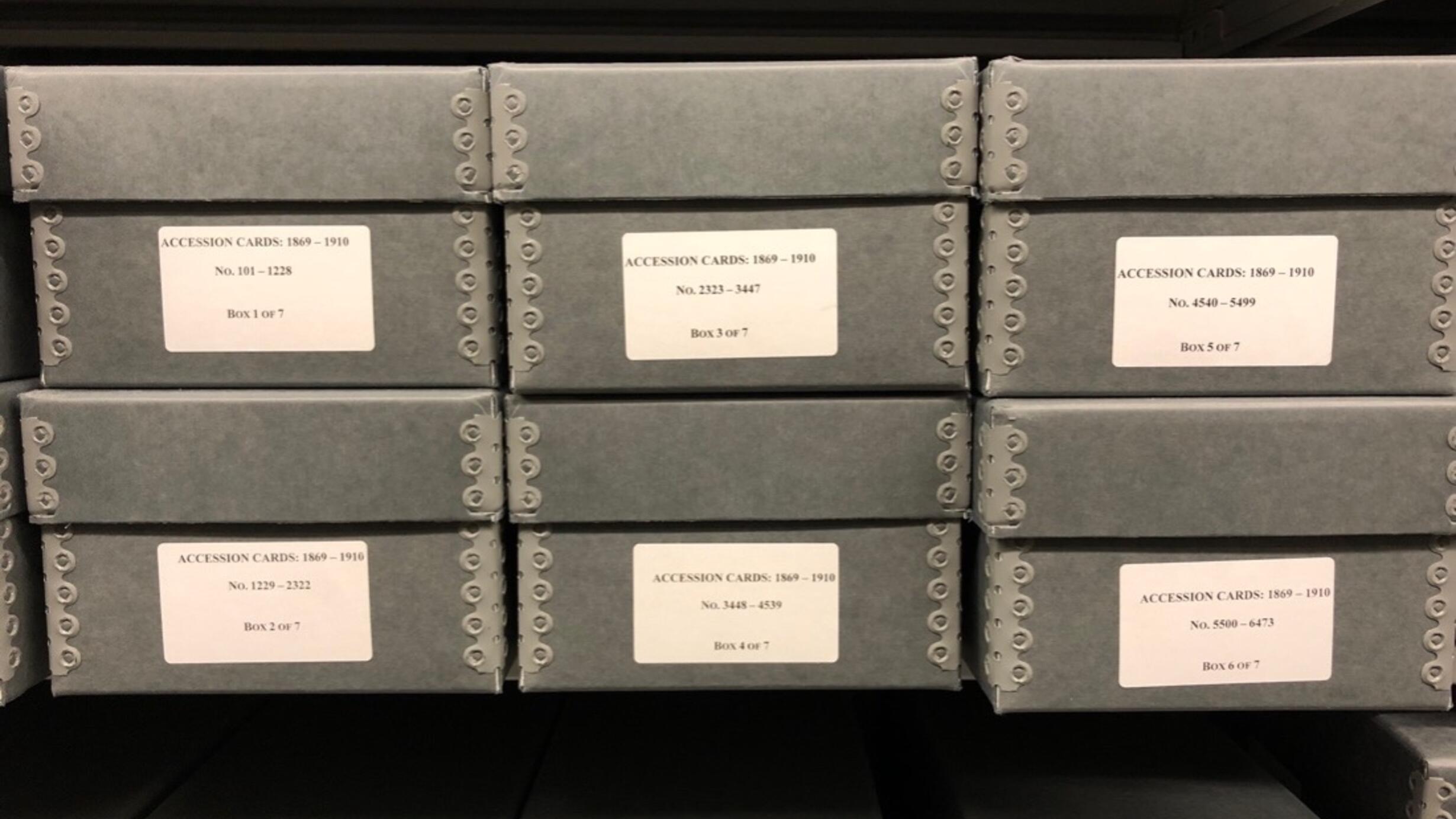Introducing the AMNH Accessions Archive Digitization Project
by Heather Knapp on
 Boxes from the American Museum of Natural History Accession Card Archive
Boxes from the American Museum of Natural History Accession Card ArchiveH. Knapp/© AMNH
A most important piece of administrative work has been the inauguration of a new system of recording accessions, loans and exchanges, which, by the energy of Mr. Pindar, and with the hearty cooperation of the departments, has put the records in most excellent and available shape for preservation and reference.
Forty-third Annual Report of the Trustees of the American Museum of Natural History for the Year 1911
Seven boxes of 6,529 index cards. Seventy-three boxes of paper files. Eighty-one additional boxes of uncounted index cards. One hundred ten boxes of accession logbooks, shipping notices, and receipts. I often wonder, when George Pindar began the process of organizing the accessions archive of the American Museum of Natural History in 1911, did he know just how valuable his record-keeping would be to us over 100 years later and that it would grow to encompass seven bookcases worth of compact storage?
Since its founding in 1869, the American Museum of Natural History has acquired over 34 million cultural artifacts and scientific specimens. As they are formally added to the Museum’s permanent collection, to be held in public trust, acquisitions (composed of one or more objects) are legally accepted via a process of review called accessioning. Accession records document the legal transaction that transfers title and establishes stewardship responsibilities of artifacts and specimens to the Museum. Although the process by which the Museum officially records accessions has evolved since Pindar was our Registrar, the vast archive continues to include the most germane information on when, how, and by whom artifacts and specimens were donated or acquired. As the Registrar for the Permanent Collections of the Museum, I continue to manage the accession records archive, and work closely with the five AMNH scientific Divisions to process all accession records for newly acquired specimens or artifacts.
Part of my job is to assist collection staff, exhibition developers, researchers and others with gleaning information from our archive, such as pinpointing accession numbers, object status (i.e., when or how it was acquired), donor details, or dates of receipt, among other information. Examples include requests for wildlife specimens for loan, either for scientific research or for display requiring confirmation of the specimen’s acquisition date and provenance; verifying identifying numbers marked on an artifact or specimen and confirming when an acquisition came in, from whom, or when it was accessioned; and confirming the historic accuracy of a collection or relationships between collections. Currently, to answer these requests, I must search the archive by hand, paper by paper, or card by card. The records are organized by chronological date, by individual department name within the five scientific Divisions, or by donor name. If we are not provided with these key pieces of information, it is nearly impossible to respond to requests. Although I thoroughly enjoy handling these aging papers up close and sifting through their contents in my search for answers, in our current age of constant access to information at our fingertips, it is well overdue for this archive to be digitized, enabling quicker access and the ability to respond to queries more efficiently.
In 2021, we embarked on a three-year project to digitize, transcribe, and provide searchable access to this archive, supported by the Institute of Museum and Library Services Museums for America grant. My office is working with staff from the Museum’s Research Library, utilizing their relatively new Digital Asset Management software to hold this archive. The Library’s service is supported by the Leon Levy Foundation as part of the Shelby White & Leon Levy Archive Initiative at the American Museum of Natural History Library.
Be sure to watch these pages as we unpack and examine over 150 years of Museum history encapsulated in our accession records.
This is the first post in a series about the Registrar’s Accessions Archive Digitization Project. This entry was written by Heather Knapp, Registrar, Permanent Collections.
This project was made possible in part by the Institute of Museum and Library Services, IMLS Grant #MA-249747-OMS-21.